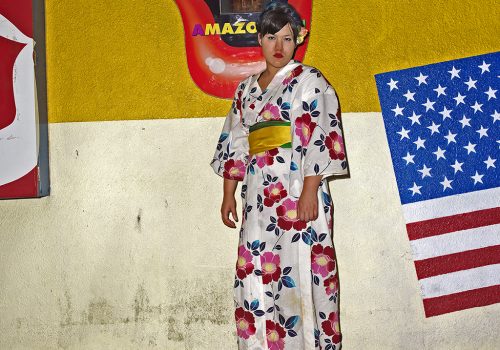Ryuichi Ishikawa’s photographs tell his version of a story in which he gets involved. As much as the literary description that he can make of it offers a coherent, historical and sequential progression as it appears in his text below, as much his graphic vision, more precisely photographic, comes in counterpoint in a process of felt, emotionalism and affectivity.
However, it is consistent through his works to find a multicultural background that allows readability for many.
“On the series « Mitsugu » by Ryuichi Ishikawa
A woman died and the urn containing her ashes was buried in the family grave of her husband. As was the custom of Okinawa. Years later, the surviving man met another woman, and they became a couple. They were the parents of Mitsugu.
The mother raised Mitsugu in a slightly unusual way, such as making him wear skirts. Already at a very young age, he was aware of his sexual preference and that he was attracted to boys, but he cannot say if it this was due to his upbringing. Mitsugu became increasingly alone in his teenage years when his male peers started to talk about girls. He was thrown inconsiderate words and became vindictive towards all those surrounding him. The word ‘bullying’ did not exist then and he did not know how to protect himself from those with malicious intents.
On the other hand, in the city he was venerated as an iconic figure with his fashion sense. He was a regular at clubs and spent days hanging out with those with whom he became friends during the night. Still, Okinawa was much too stuffy for Mitsugu and immediately upon his graduation from high school he left his hometown for Tokyo where he spent care-free nights under eternally bright lights.
People around him started to talk about flamboyant London life when he was about twenty years of ge, and he decided to go there. In Soho he found a place for himself, among gay communities, artists, rich people and gangsters. He worked in restaurants, cafe or apparel shops during the day and blasted all night. He met a man who was an artist and the two married. He was in his elements, and he wished to stay there forever, while he continued to think about his ageing parents whom he had left in Okinawa.
About twenty years into his life in the UK, he received a phone call informing him of his father’s failing heath. Mitsugu decided to return to Okinawa, leaving the now violent partner who had become consumed by alcohol and drug. Shortly after his return to his hometown, his father passed away. He was buried into the family grave, the one where his former wife rests. Mitsugu was now all alone with his mother, who became ill soon afterwards, making him take care of his own mother. Mitsugu destroyed the family Buddhist altar at home. For ten long years, the mother and the son faced each other, each trying to convince the other of his or her position and to be accepted, trying to love and be loved, a process which made both of them exhausted physically and mentally. Then his mother died.
About six months prior to Mitsugu’s mother’s death, I received a message with a photo through FaceBook. ‘I saw your photo books and I like your works. Would you want to come shoot me?’
My schedule was quite filled up and not being able to react immediately, I responded ‘I cannot come see you right away, but I will get in touch with you later.’ In reality, the photo attached to the message showing him sporting tattoos all over his face, partially triggered my reticence to accept the invitation, as I wasn’t interested in taking photos that could be solely geared to, and dictated by the wacky and eccentric appearance of the subject.
Around six months after having received the message, I sent a mail to him thinking, we can be friends first, it’s not a bad idea to meet and talk. His room was dark with curtains shut, and on a table like a make-shift Buddhist altar, was an urn. The mother of Mitsugu had died a month before. We met a couple of times and talked about ourselves. We had some common friends which boosted the energy of the conversation. While speaking, I learned that his mother’s urn had nowhere to go, and he told me that he wished to go to the beach in her hometown to scatter her ashes on the day following the Buddhist memorial service of the forty-ninth day after her death.
On the day when we went to scatter her ashes, it occurred to me to bring a professional grade film camera that an acquaintance had passed on to me several years before, and which I had rarely used. On arriving Mitsugu’s home, he told me he had by accident found an iron mortar and pestle at home that could be used to smash the bones. Events took place as in a series of miracles throughout the day. Mitsugu’s presence and behaviour on the day made me imagine how his mother must have been, a figure I will never know in person.”
Fotografia Europea
Chiostri di San Pietro
Reggio Emilia
















